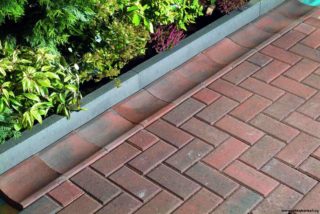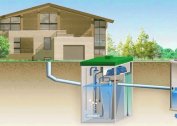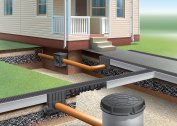High-quality drainage of storm / ground water is the key to the durability of construction on the site. If the proper actions are not taken in time, over time the object will fail due to violation of the integrity of the solid foundation. Concrete gutters are used as a ground / storm water drainage system, the price of them depends on the volume, manufacturer, type of material from which the trays are made.
Advantages and disadvantages of concrete gutters
Reinforced concrete trays have been used for storm sewers and drainage systems for more than 100 years. The main advantages of the designs are:
- High load resistance. Polymer fiber is added to the composition of reinforced concrete products as reinforcement, so the trays are able to undergo linear expansion loads.
- Corrosion-resistant properties. Concrete does not rust and does not rot even under the condition of long-term operation.
- Resistance to aggressive environments. Storm effluents mixed with reagents are not able to damage the walls of structures.
- Excellent resistance to temperature changes. Even in severe frost, concrete trays do not burst.
- Elimination of the risk of displacement of powerful rainfall due to the impressive weight of communication.
- Environmental friendliness of products. Concrete gutters do not pollute the environment; they do not emit toxins either into the ground, into the atmosphere, or into storm drains.
- Competitive price of products. It is comparatively lower than cast-iron trays and slightly higher than polymer ones (provided that gutters made of polymer concrete are purchased).
The relative disadvantages of reinforced concrete or polymer concrete trays include their weight, which requires special equipment for laying stormwater. Also to the disadvantages of the products include the measure of the rough inner surface of the gutter, on which filing may form. In polymer concrete products, the walls are quite smooth.
To avoid the growth of silt and further clogging of the sewage system, you can use the method of regular cleaning of communication, or by installing special sand traps during installation.
Types of concrete gutters
Classification of concrete gutters for water drainage on the ground occurs according to several criteria. By the type of manifold gasket, standard horizontal trays and products with a vertical spillway are distinguished.
By type of purpose, all concrete products of the gutter are:
- Stormy. Used near construction sites and public places for high-quality drainage of rainwater.
- Culverts. They are used in the construction of gravity channels for groundwater discharge.
- Telescopic. Designed to remove excess moisture channel method from road slopes and bridges.
- Drainage. Used for the installation of a drainage system from the basements of buildings and basement floors.
- Bumpy. Are applied to the device of a stormwater along automobile routes.
- Sewer. They are elements of a sewer collector.
When choosing the desired type of gutters, it is worth being guided by their load class. Depending on the purpose of the storm, more or less reinforced trays are installed. Divide them into classes:
- A15: designed for use on pedestrian sidewalks, bike paths, in private garden estates.
- B125: used in small parking lots, roads with low traffic intensity.
- C250: used for moderate traffic loads or for domestic construction. The cost of such gutters is one of the lowest.
- D400: used in large parking lots, roads with heavy traffic and in areas of small-scale industrial facilities.
- E600: designed for the device of a drainage system from a railway bed, large autobahns and highways, large industrial facilities.
- F900: the most powerful type of gutter that is used when installing a storm on the runways.
Also, all reinforced concrete trays are classified by shape:
- U-shaped;
- U-shaped;
- trapezoidal;
- parabolic.
To select the optimal concrete gutters for storm sewers, the estimated amount of rainwater should be correctly calculated. It is determined by SNiP 2.04.03-85 - for each region there is its own indicator of the volume of effluents for the year. Only after that the section of trays is selected.
The classification of concrete trays extends to the overall parameters. If the length of the products is 1 m as standard, then the internal section of the gutters varies between 100-500 mm. The smallest are used for the device of storm water.
Product Cost
The actual price of reinforced concrete gutters varies by region and manufacturer. However, on average, you can focus on the following cost:
| Tray Dimensions L / W / H (cm) | Volume, m3 | Price rub / piece |
| 110/39/37 | 0,06 | 800 |
| 120/48/28 | 0,06 | 900 |
| 240/48/28 | 0,12 | 1 800 |
| 236,5/53/30 | 0,35 | 3 600 |
| 68/30/34 | 0,038 | 2 000 |
| 110/32/2 | 0,02 | 3 800 |
| 74/49/4 | 0,02 | 3 200 |
Styling steps
Installation of household stormwater from reinforced concrete gutters can be done by yourself. The main thing is to adhere to the basic principles of the design of a sewage system. Follow these recommendations:
- Initially, a trench is prepared for the stormwater device. Its cross section and height should be 10-15 cm higher than the parameters of the gutters. The stock is then spent on strengthening the walls and bottom of the collector. When digging trenches, the slope of the drainage system is taken into account at the rate of 5 mm for each meter of the length of the gutters.
- The soil at the bottom of the canal is well rammed and covered with a layer of sand 5 cm thick. The pillow is also carefully rammed.
- A layer of crushed stone 5 cm thick is poured on top of it. A thin layer of concrete mortar is already poured on top. After solidification, it will serve as a reliable support for the gutters.
- The trays are laid on the prepared base and securely interlocked with each other using the notch-lock method. All joints are coated with acrylic / bitumen sealant.
- The walls of the installed stormwater are additionally fixed with concrete mortar on both sides.
- Ready collector is docked with the point of discharge / collection of rainwater.
- The last stage of installation is the installation of protective grilles. They can be made of cast iron, galvanized steel or polymer.
The level of the location of the finished gutter system should be below the level of the plane of the blind area, asphalt, road surface.
Subject to all recommendations, self-installation of the rainwater drainage system is straightforward. To work with heavy trays, you can use the help of a neighbor or hire special equipment. A ready-made concrete system for draining water will last for decades without the need to change its elements.






